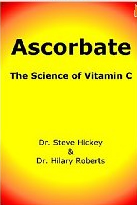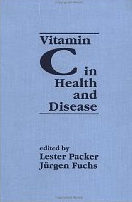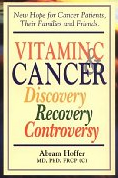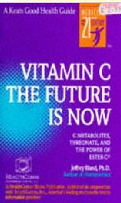
Featured Book:
Vitamin C: The Real Story, the Remarkable and Controversial Healing Factor
Vitamin C and Acidity - What Form is Best?
VITAMIN C AND ACIDITY
Reprinted with permission from Orthomolecular Medicine News Service
(OMNS, December 8, 2009) Vitamin C is commonly taken in large quantities to improve health and prevent asthma, allergies, viral infection, and heart disease. It is non-toxic and non-immunogenic, and does not irritate the stomach as drugs like aspirin can. Yet vitamin C (L-ascorbic acid) is acidic.
Understanding Vitamin C Acidity
Ascorbic acid is a weak acid (pKa= 4.2), only slightly stronger than vinegar. When dissolved in water, vitamin C is sour but less so than citric acid found in lemons and limes. Can large quantities cause problems? Sometimes, in some situations—but with simple precautions they can be avoided.
Understanding Potential Acidity Concerns
🦷 Acid in the Mouth
Any acid can etch tooth surfaces. This is why dentists warn about plaque—bacterial acid can cause cavities. Cola drinks contain phosphoric acid, actually used by dentists to etch teeth before sealants.
✅ Solutions:
- • Swallow tablets whole (don't chew)
- • Choose coated tablets
- • Rinse mouth after chewables
- • Select non-acidic chewables
🫄 Stomach Acidity
People with sensitive stomachs may experience discomfort when taking large doses (1,000-3,000+ mg every 20 minutes). However, stomach acid (HCl) is dozens of times more acidic than vitamin C.
✅ Solutions:
- • Use buffered ascorbate
- • Take with food or liquids
- • Reduce dose if bowel tolerance reached
- • Many report no problems even at 20,000mg/hour
⚖️ Body pH Balance
The body actively and constantly controls blood pH. Kidneys regulate acid over hours to days, while breathing rate adjusts pH within minutes to hours.
✅ Good News:
- • Body maintains pH automatically
- • Vitamin C is weak acid—well tolerated
- • May actually reduce kidney stones
- • No evidence of causing kidney stones



Forms of Vitamin C: Finding Your Best Option
Ascorbate comes in many forms, each with particular advantages. Here's your complete guide:
💊 Basic Ascorbic Acid Forms
Large Tablets (1000-1500mg)
Convenient and relatively inexpensive. Good for daily maintenance.
⚠️ Cons: May cause stomach upset in sensitive people
Timed-Release Tablets
Contain long-chain carbohydrates that delay stomach dissolution, releasing over hours.
⚠️ Cons: More expensive than regular tablets
Powder/Crystals
Pure powder dissolves faster than tablets. Linus Pauling's preferred form—free of tableting excipients.
⚠️ Cons: Measuring required, sour taste
🛡️ Buffered Ascorbate (Stomach-Friendly)
DIY Buffering Method
Add a fraction of a teaspoon of aluminum-free sodium bicarbonate (baking soda) like Bob's Red Mill to ascorbic acid. The bicarbonate fizzes, neutralizing the acidity.
Calcium Ascorbate
Non-acidic, safe for mouth and sensitive stomachs. Can be applied directly to gums for infections.
⚠️ Slightly metallic taste, astringent
Sodium Ascorbate
Gentle on stomach, dissolves easily in water.
⚠️ Cons: Contains sodium (watch if salt-restricted)
Magnesium Ascorbate
Provides both vitamin C and magnesium. Adults need 400-600mg magnesium daily.
⚠️ Cons: More expensive than basic forms
📝 Note: Buffered forms are better tolerated at higher doses but may be less effective for preventing acute cold symptoms. They require absorbing an electron from the body to become effective as native ascorbate.
🔬 Advanced & Specialized Forms
🧬 Liposomal Vitamin C
Revolutionary form packaged inside nano-scale phospholipid spheres (liposomes), like cell membranes. Protects vitamin C from degradation and facilitates intracellular uptake.
⚡ Claims: 5-10 fold more absorbable than straight ascorbic acid
💰 Cost: More expensive than tablets or powder
🧪 Ascorbyl Palmitate
Ascorbate bound to palmitic acid. Amphipathic (dissolves in water or fat). Used in processed foods and topical creams for stability.
📝 Note: When ingested, decomposes into separate ascorbate and palmitic acid
💰 Cost: More expensive than ascorbic acid
🌿 Natural Ascorbate Sources
Plant-Derived Sources
- 🍒 Acerola (Barbados cherry): High vitamin C content, traditional cold fighter
- 🌹 Rose hips: Traditional source with natural bioflavonoids
Reality check: Generally low-dose and considerably more expensive. Pauling stated naturally-derived vitamin C is no better than pure commercial ascorbate.
Bioflavonoids
Antioxidants found in citrus fruits thought to improve vitamin C uptake and utilization. Most supplement tablets don't contain enough to make much difference.
💡 Budget tip: Buy vitamin C inexpensively regardless of bioflavonoids. Get bioflavonoids from citrus fruits, peppers, and vegetables.
🎯 Quick Selection Guide
💰 Budget-Conscious
Ascorbic acid powder or large tablets
🫄 Sensitive Stomach
Calcium or magnesium ascorbate
🦷 Dental Concerns
Non-acidic chewables or buffered forms
⚡ Maximum Absorption
Liposomal vitamin C (if budget allows)

References & Further Reading
[1] Hickey S, Saul AW (2008) Vitamin C: The Real Story
[2] Pauling L (1986) How to Live Longer and Feel Better
[3] Handbook of Chemistry and Physics (2004), CRC Press
[4] Getting children to take vitamin C
[5] Cathcart RF (1981) Vitamin C, titrating to bowel tolerance
[6] Dean C (2006) The Magnesium Miracle
[8] Healing gums with buffered ascorbate
Nutritional Medicine is Orthomolecular Medicine
Orthomolecular medicine uses safe, effective nutritional therapy to fight illness.
Learn More
http://www.orthomolecular.orgSubscribe (Free)
Orthomolecular Medicine News ServiceEditorial Review Board
- Carolyn Dean, M.D., N.D.
- Damien Downing, M.D.
- Michael Gonzalez, D.Sc., Ph.D.
- Steve Hickey, Ph.D.
- James A. Jackson, PhD
- Bo H. Jonsson, MD, Ph.D
- Thomas Levy, M.D., J.D.
- Jorge R. Miranda-Massari, Pharm.D.
- Erik Paterson, M.D.
- Gert E. Shuitemaker, Ph.D.
Andrew W. Saul, Ph.D., Editor and contact person.
The peer-reviewed Orthomolecular Medicine News Service is a non-profit and non-commercial informational resource.